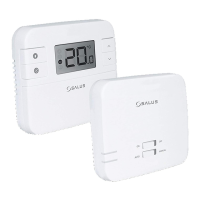
Do you have a question about the Salus RT310RF and is the answer not in the manual?
| Type | Wireless thermostat |
|---|---|
| Frequency | 868 MHz |
| Temperature Range | 5°C to 35°C |
| Power Supply | 2 x AA batteries |
| Display | LCD |
| Mounting | Wall-mounted |
| Programmable | Yes |
| Frost Protection | Yes |
| Holiday Mode | Yes |
| Control Mode | Manual |
| Communication | RF (Radio Frequency) |
| Range | Up to 30 meters (open space) |
| Compatibility | Boilers |
| Dimensions | 120mm |
Product compliance with EU directives and availability of the Declaration of Conformity.
Essential safety precautions for installation, use, and maintenance of the device.
Lists the items included in the RT310RF thermostat package, including the thermostat, receiver, and accessories.
Guidelines and diagrams for optimal placement of the thermostat for accurate temperature sensing.
Step-by-step instructions for mounting the thermostat onto a wall using the provided bracket.
Instructions on how to use the thermostat as a free-standing unit with the included bracket.
Explanation of the various icons displayed on the thermostat's LCD screen.
Details on the function of each button on the thermostat.
Step-by-step guide for the initial power-up and basic configuration of the thermostat.
Description of the function of the top and bottom switches on the RXRT510 receiver.
Explanation of the meaning of the red and green LEDs on the RXRT510 receiver.
Detailed instructions for securely mounting the RXRT510 receiver on a wall.
Wiring diagrams and explanations for connecting the thermostat and receiver to the heating system.
How to adjust the temperature setpoint when the thermostat is in manual mode.
Instructions for activating and using the frost protection mode to prevent freezing.
Steps to activate and deactivate the sleep mode for energy saving.
Guide to switching between heating and cooling modes and understanding their indicators.
How the thermostat displays temperatures that are above or below the measurable range.
Information on the low battery warning indicator and battery replacement.
Explanation of DIP switch functions for selecting control algorithms.